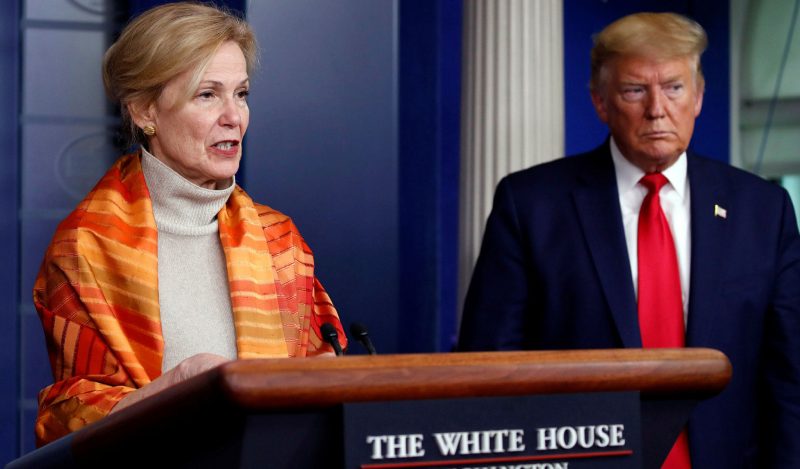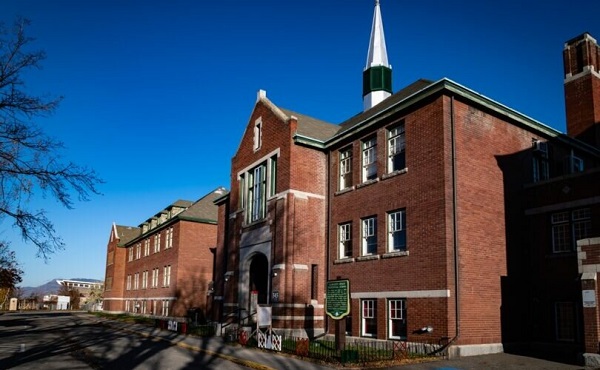Brownstone Institute
It Was Birx. All Birx.

BY
In two previous articles, I looked into the shady circumstances surrounding Deborah Birx’s appointment to the White House Coronavirus Response Task Force and the laughable lack of actual science behind the claims she used to justify her testing, masking, distancing and lockdown policies.
Considering all that, the questions arise: Who was actually in charge of Deborah Birx and whom was she working with?
But first: Who cares?
Here’s why I think it’s important: If we can show that Birx and the others who imposed totalitarian anti-scientific testing, masking, social distancing, and lockdown policies, knew from the get-go that these policies would not work against an airborne respiratory virus, and nevertheless they imposed them FOR REASONS OTHER THAN PUBLIC HEALTH, then there is no longer acceptable justification for any of those measures.
Furthermore, whatever mountains of post-facto bad science were concocted to rationalize these measures are also completely bunk. Instead of having to go through each ridiculous pseudo-study to demonstrate its scientific worthlessness, we can throw the whole steaming pile in the garbage heap of history, where it belongs, and move on with our lives.
In my admittedly somewhat naive optimism, I also hope that by exposing the non-scientific, anti-public-health origins of the Covid catastrophe, we may lower the chances of it happening again.
And now, back to Birx.
She did not work for or with Trump
We know Birx was definitely not working with President Trump, although she was on a task force ostensibly representing the White House. Trump did not appoint her, nor did the leaders of the Task Force, as Scott Atlas recounts in his revelatory book on White House pandemic lunacy, A Plague Upon Our House. When Atlas asked Task Force members how Birx was appointed, he was surprised to find that “no one seemed to know.” (Atlas, p. 82)
Yet, somehow, Deborah Birx – a former military AIDS researcher and government AIDS ambassador with no training, experience or publications in epidemiology or public health policy – found herself leading a White House Task Force on which she had the power to literally subvert the policy prescriptions of the President of the United States.
As she describes in The Silent Invasion, Birx was shocked when “at the halfway point of our 15 Days to Slow the Spread campaign, President Trump stated that he hoped to lift all restrictions by Easter Sunday.” (Birx, p. 142) She was even more dismayed when “mere days after the president had announced the thirty-day extension of the Slow the Spread campaign to the American public” he became enraged and told her “‘We will never shut down the country again. Never.’” (Birx, p. 152)
Clearly, Trump was not on board with the lockdowns, and every time he was forced to go along with them, he became enraged and lashed out at Birx – the person he believed was forcing him.
Birx laments that “from here on out, everything I worked toward would be harder—in some cases, impossible,” and goes on to say she would basically have to work behind the scenes against the President, having “to adapt to effectively protect the country from the virus that had already silently invaded it.” (Birx, pp. 153-4)
Which brings us back to the question: Where did Birx get the nerve and, more mysteriously, the authority to so blithely act in direct opposition to the President she was supposed to serve, on matters affecting the lives of the entire population of the United States?
Atlas regrets what he thinks was President Trump’s “massive error in judgment.” He argues that Trump acted “against his own gut feeling” and “delegated authority to medical bureaucrats, and then he failed to correct that mistake.” (Atlas, p. 308)
Although I believe massive errors in judgment were not unusual for President Trump, I disagree with Atlas on this one. In the case of the Coronavirus Response Task Force, I actually think there was something much more insidious at play.
Trump had no power over Birx or pandemic response
Dr. Paul Alexander, an epidemiologist and research methodology expert who was recruited to advise the Trump administration on pandemic policy, tells a shocking story in an interview with Jeffrey Tucker, in which bureaucrats at the Department of Health and Human Services (HHS) and lawyers from the Justice Department told him to resign, despite direct orders from President Trump and the White House: “We want you to understand that President Trump has no power,” they reportedly told Alexander. “He cannot tell us what to do.”
Alexander believes these bureaucrats represented the “deep state” which, he was told repeatedly, had decided first not to hire or pay him, and then to get rid of him. Alexander also writes in an upcoming exposé that the entrenched government bureaucracy, particularly at the NIH, CDC, and WHO, used the pandemic response to doom President Trump’s chances for reelection.
Was the entire anti-scientific totalitarian pandemic response, all over the world, a political maneuver to get rid of Trump? It’s possible. I would contend, however, that the politics were only a sideshow to the main event: the engineered virus lab leak and coverup. I believe the “deep state” Alexander repeatedly butted up against was not just the entrenched bureaucracy, but something even deeper and more powerful.
Which brings us back to deep state frontwoman Deborah Birx.
After lamenting Trump’s delegation of authority to “medical bureaucrats,” Scott Atlas also hints at forces beyond Trump’s control. “The Task Force was called ‘the White House Coronavirus Task Force,’” Atlas notes, “but it was not in sync with President Trump. It was directed by Vice President Pence.” (Atlas, p. 306) Yet, whenever Atlas tried to raise questions about Birx’s policies, he was directed to speak with Pence, who then failed to ever address anything with Birx:
“Given that the VP was in charge of the Task Force, shouldn’t the bottom-line advice emanating from it comport with the policies of the administration? But he would never speak with Dr. Birx at all. In fact, (Marc) Short [Pence’s chief of staff], clearly representing the VP’s interests above all else, would do the opposite, telephoning others in the West Wing, imploring friends of mine to tell me to avoid alienating Dr. Birx.” (Atlas, p. 165-6)
Recall that Pence replaced Alex Azar as Task Force director on February 26, 2020 and Birx’s appointment as coordinator, at the instigation of Asst. National Security Advisor Matt Pottinger, came on February 27th. Subsequent to those two appointments, it was Birx who was effectively in charge of United States coronavirus policy.
What was driving that policy, once she took over? As Birx writes, it was the NSC (National Security Council) that appointed her, through Pottinger, and it was her job to “reinforce their warnings” – which, I continue to speculate, were related to the accidental release of an enhanced pandemic potential pathogen from a US-funded lab in Wuhan.
Trump was probably made aware of this, as evidenced not just by his repeated mentions, but by what Time Magazine called his uncharacteristic refusal to explain why he believed it. The magazine quotes Trump saying “I can’t tell you that,” when asked about his belief in the lab leak. And he repeats, “I’m not allowed to tell you that.”
Why in the world was the President of the United States not allowed to override AIDS researcher/diplomat Birx on lockdown policies nor explain to the public why he believed there was a lab leak?
The answer, I believe, is that Trump was uncharacteristically holding back because he was told (by Birx, Pottinger and the military/intelligence/biosecurity interests for whom they worked) that if he did not go along with their policies and proclamations, millions of Americans would die. Why? Because SARS-CoV-2 was not just another zoonotic virus. It was an engineered virus that needed to be contained at all costs.
As Dr. Atlas repeatedly notes with great dismay: “the Task Force doctors were fixated on a single-minded view that all cases of COVID must be stopped or millions of Americans would die.” (Atlas, p. 155-6) [BOLDFACE ADDED]
That was the key message, wielded with great force and success against Trump, his administration, the press, the states, and the public, to suppress any opposition to lockdown policies. Yet the message makes no sense if you believe SARS-CoV-2 is a virus that jumped from a bat to a person in a wet market, severely affecting mostly people who are old and debilitated. It only makes sense if you think, or know, that the virus was engineered to be especially contagious or deadly (even if its behavior in the population at any given moment might not justify that level of alarm).
But, again, before indulging in more speculation, let’s get back to Birx. Who else did she (and her hidden handlers) bulldoze?
She dictated policy to the entire Trump administration
In his book, Atlas observes with puzzlement and consternation that, although Pence was the nominal director of the Task Force, Deborah Birx was the person in charge: “Birx’s policies were enacted throughout the country, in almost every single state, for the entire pandemic—this cannot be denied; it cannot be deflected.” (Atlas, p. 222)
Atlas is “dumbstruck at the lack of leadership in the White House,” in which, “the president was saying one thing while the White House Task Force representative was saying something entirely different, indeed contradictory” and, as he notes, “no one ever set her [Birx] straight on her role.” (Atlas, p. 222-223)
Not only that, but no matter how much Trump, or anyone in the administration, disagreed with Birx, “the White House was held hostage to the anticipated reaction of Dr. Birx” and she “was not to be touched, period.” (Atlas, p. 223)
One explanation for her untouchableness, Atlas suggests, is that Birx and her policies became so popular with the press and public that the administration did not want to “rock the boat” by replacing her before the election. This explanation, however, as Atlas himself realizes, crumbles in the face of what we know about Trump and the media’s hostility towards him:
“They [Trump’s advisors] had convinced him to do exactly the opposite of what he would naturally do in any other circumstance—to disregard his own common sense and allow grossly incorrect policy advice to prevail. … This president, widely known for his signature ‘You’re fired!’ declaration, was misled by his closest political intimates. All for fear of what was inevitable anyway—skewering from an already hostile media.” (Atlas, p. 300-301)
I would suggest, again, the reason for the seemingly inexplicable lack of gumption on Trump’s part to get rid of Birx was not politics, but behind-the-scenes machinations of the (to coin a moniker) lab leak cabal.
Who else was part of this cabal with its hidden agendas and oversized policy influence? Our attention naturally turns to the other members of the Task Force who were presumably co-engineering lockdown policies with Birx. Surprising revelations emerge.
There was no troika. No Birx-Fauci lockdown plan. It was all Birx.
It is universally assumed, by both those in favor and those opposed to the Task Force’s policy prescriptions, that Drs. Deborah Birx, Tony Fauci (head of NIAID at the time) and Bob Redfield (then director of the CDC) worked together to formulate those policies.
The stories told by Birx herself and Task Force infiltrator Scott Atlas suggest otherwise.
Like everyone else, at the onset of his book, Atlas asserts: “The architects of the American lockdown strategy were Dr. Anthony Fauci and Dr. Deborah Birx. With Dr. Robert Redfield… they were the most influential medical members of the White House Coronavirus Task Force.” (Atlas, p. 22)
But as Atlas’s story unfolds, he presents a more nuanced understanding of the power dynamics on the Task Force:
“Fauci’s role surprised me the most. Most of the country, indeed the entire world, assumed that Fauci occupied a directorial role in the Trump administration’s Task Force. I had also thought that from viewing the news,” Atlas admits. However, he continues, “The public presumption of Dr. Fauci’s leadership role on the Task Force itself…could not have been more incorrect. Fauci held massive sway with the public, but he was not in charge of anything specific on the Task Force. He served mainly as a channel for updates on the trials of vaccines and drugs.” (p. 98) [BOLDFACE ADDED]
By the end of the book, Atlas fully revises his initial assessment, strongly emphasizing that, in fact, it was primarily and predominantly Birx who designed and disseminated the lockdown policies:
“Dr. Fauci held court in the public eye on a daily basis, so frequently that many misconstrue his role as being in charge. However, it was really Dr. Birx who articulated Task Force policy. All the advice from the Task Force to the states came from Dr. Birx. All written recommendations about their on-the-ground policies were from Dr. Birx. Dr. Birx conducted almost all the visits to states on behalf of the Task Force.” (Atlas, p. 309-10) [BOLDFACE ADDED]
It may sound jarring and unlikely, given the public perception of Fauci, as Atlas notes. But in Birx’s book the same unexpected picture emerges.
Methinks the lady doth protest too much
As with her bizarrely self-contradictory statements about how she got hired, and her blatantly bogus scientific claims, Birx’s story about her mind-melded closeness with Fauci and Redfield falls apart upon closer examination.
In her book, Birx repeatedly claims she trusts Redfield and Fauci “implicitly to help shape America’s response to the novel coronavirus.” (Birx, p. 31) She says she has “every confidence, based on past performance, that whatever path the virus took, the United States and the CDC would be on top of the situation.” (Birx, p. 32)
Then, almost immediately, she undermines the credibility of those she supposedly trusts, quoting Matt Pottinger as saying she “‘should take over Azar, Fauci, and Redfield’s jobs, because you’re such a better leader than they are.’” (Birx, p. 38-9)
Perhaps she was just giving herself a little pat on the back, one might innocently suggest. But wait. There’s so much more.
Birx claims that in a meeting on January 31 “everything Drs. Fauci and Redfield said about their approach made sense based on the information available to me at that point,” even though “neither of them spoke” about the two issues she was most obsessed with: “asymptomatic silent spread [and] the role testing should play in the response.” (Birx, p. 39)
Then, although she says she “didn’t read too much into this omission,” (p. 39) just two weeks later, “as early as February 13” Birx again mentions “a lack of leadership and direction in the CDC and the White House Coronavirus Task Force.” (p. 54)
So does Debi trust Tony and Bob’s leadership or does she not? The only answer is more self-contradictory obfuscation.
Birx is horrified that nobody is taking the virus as seriously as they should: “then I saw Tony and Bob repeating that the risk to Americans was low,” she reports. “On February 8, Tony said that the chances of contracting the virus were ‘minuscule.’” And, “on February 29, he said, ‘Right now, at this moment, there is no need to change anything you’re doing on a day-to-day basis.’” (Birx, p. 57)
This does not seem like the kind of leader Birx can trust. She half-heartedly tries to excuse Redfield and Fauci, saying “I now believe that Bob and Tony’s words had spoken to the limited data they had access to from the CDC,” and then, in another whiplash moment, “maybe they had data in the United States that I did not.”
Did Tony and Bob provide less dire warnings because they had insufficient data or because they had more data than Birx did? She never clarifies, but regardless, she assures us that she “trusted them” and “felt reassured every day with them on the task force.” (Birx, p. 57)
If I was worried that the virus was not being taken seriously enough, Birx’s reports on Bob and Tony would not be very reassuring, to say the least.
Apparently, Birx herself felt that way too. “I was somewhat disappointed that Bob and Tony weren’t seeing the situation as I was,” she says, when they disagreed with her alarmist assessments of asymptomatic spread. But, she adds, “at least their number supported my belief that this new disease was far more asymptomatic than the flu. I wouldn’t have to push them as far as I needed to push the CDC.” (Birx, p. 78)
Is someone who disagrees with your assessment to the point that you need to push them in your direction also someone you “implicitly trust” to lead the US through the pandemic?
Apparently, not so much.
Although she supposedly trusts Redfield and sleeps well at night knowing he’s on the Task Force, Birx has nothing but disdain and criticism for the CDC – the organization Redfield leads.
“On aggressive testing I planned to have Tom Frieden [CDC director under Obama] help bring the CDC along,” she recounts. “Like me, the CDC wanted to do everything to stop the virus, but the agency needed to align with us on aggressive testing and silent spread.” (p. 122) Which makes one wonder: If she was so closely aligned with Redfield, the head of the CDC, why did Birx need to bring in a former director – in a direct challenge to the sitting one – to “bring the CDC along?” Who is “us” if not Birx, Fauci and Redfield?
Masks were another issue of apparent contention. Birx is frustrated because the CDC, led by her “we’ve-got-each-other’s-back” bestie, Bob Redfield (Birx, p. 31), will not issue strict enough masking guidelines. In fact, she repeatedly throws Bob’s organization under the bus, basically accusing them of causing American deaths: “For many weeks and months to come,” she writes, “I fretted over how many lives could have been saved if the CDC had trusted the public to understand that …masks would do no harm and could potentially do a great deal of good.” (Birx, p. 86)
Apparently, Fauci was not on board with the masking either, as Birx says that “getting the doctors, including Tom [Frieden] and Tony, to be in complete agreement with me about asymptomatic spread was slightly less of a priority. As with masks, I knew I could return to that issue as soon as I got their buy-in on our recommendations.” (Birx, p. 123)
Who is making “our recommendations” if not Birx, Fauci and Redfield?
The myth of the troika
Whether or not she trusted them (and it’s hard to believe, based on her own accounts, that she did), it was apparently very important to Birx that she, Fauci and Redfield appear as a single entity with no disagreements whatsoever.
When Scott Atlas, an outsider not privy to whatever power plays were happening on the Task Force, came in, his presence apparently rattled Birx (Atlas, p. 83-4), and for good reason. Atlas immediately noticed strange goings-on. In his book, he repeatedly uses words like “bizarre,” “odd” and “uncanny” to describe how Fauci, Redfield and Birx behaved. Most notably, they never ever questioned or disagreed with one another in Task Force meetings. Not ever.
“They shared thought processes and views to an uncanny level,” Atlas writes, then reiterates that “there was virtually no disagreement among them.” What he saw “was an amazing consistency, as though there were an agreed-upon complicity” (Atlas, pp. 99-100). They “virtually always agreed, literally never challenging one another.” (p. 101) [BOLDFACE ADDED]
An agreed-upon complicity? Uncanny agreement? Based on all of the disagreements reported by Birx and her repeated questioning and undermining of Bob and Tony’s authority, how can this be explained?
I would contend that in order to obscure the extent to which Birx alone was in charge of Task Force policy, the other doctors were compelled to present a facade of complete agreement. Otherwise, as with any opposition to, or even discussion of, potential harms of lockdown policies, “millions of Amercans would die.”
This assessment is strengthened by Atlas’s ongoing bafflement and distress at how the Task Force – and particularly the doctors/scientists who were presumably formulating policy based on data and research – functioned:
“I never saw them act like scientists, digging into the numbers to verify the very trends that formed the basis of their reactive policy pronouncements. They did not act like researchers, using critical thinking to dissect the published science or differentiate a correlation from a cause. They certainly did not show a physician’s clinical perspective. With their single-minded focus, they did not even act like public health experts.” (Atlas, p. 176)
Atlas was surprised, indeed stunned, that “No one on the Task Force presented any data” to justify lockdowns or to contradict the evidence on lockdown harms that Atlas presented. (Atlas, p. 206) More specifically, no data or research was ever presented (except by Atlas) to contradict or question anything Birx said. “Until I arrived,” Atlas observes, “no one had challenged anything she said during her six months as the Task Force Coordinator.” (Atlas, p. 234) [BOLDFACE ADDED]
Atlas cannot explain what he’s witnessing. “That was all part of the puzzle of the Task Force doctors,” he states. “There was a lack of scientific rigor in meetings I attended. I never saw them question the data. The striking uniformity of opinion by Birx, Redfield, Fauci, and (Brett) Giroir [former Admiral and Task Force “testing czar”] was not anything like what I had seen in my career in academic medicine.” (Atlas, p. 244)
How can we explain the puzzle of this uncanny apparent complicity by the Task Force troika?
Methinks the intelligence agent also doth protest too much
An interesting hint comes from the string of anecdotes comprising Matthew Lawrence’s New Yorker article “The Plague Year.” Lawrence writes that Matt Pottinger (the NSC liaison to Birx) tried to convince Task Force members that masking could stop the virus “‘dead in its tracks’” but his views “stirred up surprisingly rigid responses from the public-health contingent.” Lawrence continues to report that “In Pottinger’s opinion, when Redfield, Fauci, Birx, and (Stephen) Hahn spoke, it could sound like groupthink,” implying that those were the members of the “public-health contingent” who did not agree with Pottinger’s masking ideas.
But wait. We just noted Birx’s frustration, indeed deep regret, that the CDC led by Redfield, as well as Fauci (and even Frieden) did not agree with her ideas on asymptomatic spread and masking. So why does Pottinger imply that she and the “public-health contingent” of the Task Force were group-thinking this issue, against him?
I would suggest that the only way to make sense of these contradictions within Birx’s narrative and between her, Atlas and Pottinger’s stories, is if we understand “align with us” and “our recommendations” to refer not to the perceived Birx-Fauci-Redfield troika, but to the Birx-Pottinger-lab leak cabal that was actually running the show.
In fact, Birx and Pottinger put so much effort into insisting on the solidarity of the troika, even when it contradicts their own statements, that the question inevitably arises: what do they have to gain from it? The benefit of insisting that Birx was allied with Fauci, Redfield and the “public-health contingent” on the Task Force, I would argue, is that this deflects attention from the Birx-Pottinger-cabal non-public-health alliance.
Her authority and policies emanated from a hidden source
The explanation of Atlas’s perceived “puzzle of the Task Force doctors” that makes the most sense to me is that Deborah Birx, in contrast and often in opposition to the other doctors on the Task Force, represented the interests of what I’m calling the lab leak cabal: those not just in the US but in the international intelligence/biosecurity community who needed to cover up a potentially devastating lab leak and who wanted to impose draconian lockdown measures such as the world had never known.
Who exactly they were and why they needed lockdowns are subjects of ongoing investigations.
In the meantime, once we separate Birx from Trump, from the rest of the administration, and from the others on the Task Force, we can see clearly that her single-minded and scientifically nonsensical emphasis on silent spread and asymptomatic testing was geared toward a single goal: to scare everyone so much that lockdowns would appear to be a sensible policy. This is the same strategy that was, uncannily in my opinion, implemented almost to the letter in nearly every other country around the world. But that’s for the next article.
I’ll close this chapter of the Birx riddle wrapped in a mystery inside an enigma, with Scott Atlas’s report of his parting conversation with President Trump:
“‘You were right about everything, all along the way,’” Trump said to Atlas. “‘And you know what? You were also right about something else. Fauci wasn’t the biggest problem of all of them. It really wasn’t him. You were right about that.’ I found myself nodding as I held the phone in my hand,” Atlas says. “I knew exactly whom he was talking about.” (Atlas, p. 300)
And now, so do we.
Brownstone Institute
Net Zero: The Mystery of the Falling Fertility

From the Brownstone Institute
By
If you want to argue that a mysterious factor X is responsible for the drop in fertility, you will have to explain (1) why the factor affected only the vaccinated, and (2) why it started affecting them at about the time of vaccination.
In January 2022, the number of children born in the Czech Republic suddenly decreased by about 10%. By the end of 2022, it had become clear that this was a signal: All the monthly numbers of newborns were mysteriously low.
In April 2023, I wrote a piece for a Czech investigative platform InFakta and suggested that this unexpected phenomenon might be connected to the aggressive vaccination campaign that had started approximately 9 months before the drop in natality. Denik N – a Czech equivalent of the New York Times – immediately came forward with a “devastating takedown” of my article, labeled me a liar and claimed that the pattern can be explained by demographics: There were fewer women in the population and they were getting older.
To compare fertility across countries (and time), the so-called Total Fertility Rate (TFR) is used. Roughly speaking, it is the average number of children that are born to a woman over her lifetime. TFR is independent of the number of women and of their age structure. Figure 1 below shows the evolution of TFR in several European countries between 2001 and 2023. I selected countries that experienced a similar drop in TFR in 2022 as the Czech Republic.

So, by the end of 2023, the following two points were clear:
- The drop in natality in the Czech Republic in 2022 could not be explained by demographic factors. Total fertility rate – which is independent of the number of women and their age structure – dropped sharply in 2022 and has been decreasing ever since. The data for 2024 show that the Czech TFR has decreased further to 1.37.
- Many other European countries experienced the same dramatic and unexpected decrease in fertility that started at the beginning of 2022. I have selected some of them for Figure 1 but there are more: The Netherlands, Norway, Slovakia, Slovenia, and Sweden. On the other hand, there are some countries that do not show a sudden drop in TFR, but rather a steady decline over a longer period (e.g. Belgium, France, UK, Greece, or Italy). Notable exceptions are Bulgaria, Spain, and Portugal where fertility has increased (albeit from very low numbers). The Human Fertility Project database has all the numbers.
This data pattern is so amazing and unexpected that even the mainstream media in Europe cannot avoid the problem completely. From time to time, talking heads with many academic titles appear and push one of the politically correct narratives: It’s Putin! (Spoiler alert: The war started in February 2022; however, children not born in 2022 were not conceived in 2021). It’s the inflation caused by Putin! (Sorry, that was even later). It’s the demographics! (Nope, see above, TFR is independent of the demographics).
Thus, the “v” word keeps creeping back into people’s minds and the Web’s Wild West is ripe with speculation. We decided not to speculate but to wrestle some more data from the Czech government. For many months, we were trying to acquire the number of newborns in each month, broken down by age and vaccination status of the mother. The post-socialist health-care system of our country is a double-edged sword: On one hand, the state collects much more data about citizens than an American would believe. On the other hand, we have an equivalent of the FOIA, and we are not afraid to use it. After many months of fruitless correspondence with the authorities, we turned to Jitka Chalankova – a Czech Ron Johnson in skirts – who finally managed to obtain an invaluable data sheet.
To my knowledge, the datasheet (now publicly available with an English translation here) is the only officially released dataset containing a breakdown of newborns by the Covid-19 vaccination status of the mother. We requested much more detailed data, but this is all we got. The data contains the number of births per month between January 2021 and December 2023 given by women (aged 18-39) who were vaccinated, i.e., had received at least one Covid vaccine dose by the date of delivery, and by women who were unvaccinated, i.e., had not received any dose of any Covid vaccine by the date of delivery.
Furthermore, the numbers of births per month by women vaccinated by one or more doses during pregnancy were provided. This enabled us to estimate the number of women who were vaccinated before conception. Then, we used open data on the Czech population structure by age, and open data on Covid vaccination by day, sex, and age.
Combining these three datasets, we were able to estimate the rates of successful conceptions (i.e., conceptions that led to births nine months later) by preconception vaccination status of the mother. Those interested in the technical details of the procedure may read Methods in the newly released paper. It is worth mentioning that the paper had been rejected without review in six high-ranking scientific journals. In Figure 2, we reprint the main finding of our analysis.

Figure 2 reveals several interesting patterns that I list here in order of importance:
- Vaccinated women conceived about a third fewer children than would be expected from their share of the population. Unvaccinated women conceived at about the same rate as all women before the pandemic. Thus, a strong association between Covid vaccination status and successful conceptions has been established.
- In the second half of 2021, there was a peak in the rate of conceptions of the unvaccinated (and a corresponding trough in the vaccinated). This points to rather intelligent behavior of Czech women, who – contrary to the official advice – probably avoided vaccination if they wanted to get pregnant. This concentrated the pregnancies in the unvaccinated group and produced the peak.
- In the first half of 2021, there was significant uncertainty in the estimates of the conception rates. The lower estimate of the conception rate in the vaccinated was produced by assuming that all women vaccinated (by at least one dose) during pregnancy were unvaccinated before conception. This was almost certainly true in the first half of 2021 because the vaccines were not available prior to 2021. The upper estimate was produced by assuming that all women vaccinated (by at least one dose) during pregnancy also received at least one dose before conception. This was probably closer to the truth in the second part of 2021. Thus, we think that the true conception rates for the vaccinated start close to the lower bound in early 2021 and end close to the upper bound in early 2022. Once again, we would like to be much more precise, but we have to work with what we have got.
Now that the association between Covid-19 vaccination and lower rates of conception has been established, the one important question looms: Is this association causal? In other words, did the Covid-19 vaccines really prevent women from getting pregnant?
The guardians of the official narrative brush off our findings and say that the difference is easily explained by confounding: The vaccinated tend to be older, more educated, city-dwelling, more climate change aware…you name it. That all may well be true, but in early 2022, the TFR of the whole population dropped sharply and has been decreasing ever since.
So, something must have happened in the spring of 2021. Had the population of women just spontaneously separated into two groups – rednecks who wanted kids and didn’t want the jab, and city slickers who didn’t want kids and wanted the jab – the fertility rate of the unvaccinated would indeed be much higher than that of the vaccinated. In that respect, such a selection bias could explain the observed pattern. However, had this been true, the total TFR of the whole population would have remained constant.
But this is not what happened. For some reason, the TFR of the whole population jumped down in January 2022 and has been decreasing ever since. And we have just shown that, for some reason, this decrease in fertility affected only the vaccinated. So, if you want to argue that a mysterious factor X is responsible for the drop in fertility, you will have to explain (1) why the factor affected only the vaccinated, and (2) why it started affecting them at about the time of vaccination. That is a tall order. Mr. Occam and I both think that X = the vaccine is the simplest explanation.
What really puzzles me is the continuation of the trend. If the vaccines really prevented conception, shouldn’t the effect have been transient? It’s been more than three years since the mass vaccination event, but fertility rates still keep falling. If this trend continues for another five years, we may as well stop arguing about pensions, defense spending, healthcare reform, and education – because we are done.
We are in the middle of what may be the biggest fertility crisis in the history of mankind. The reason for the collapse in fertility is not known. The governments of many European countries have the data that would unlock the mystery. Yet, it seems that no one wants to know.
Author
Brownstone Institute
FDA Exposed: Hundreds of Drugs Approved without Proof They Work

From the Brownstone Institute
By
The US Food and Drug Administration (FDA) has approved hundreds of drugs without proof that they work—and in some cases, despite evidence that they cause harm.
That’s the finding of a blistering two-year investigation by medical journalists Jeanne Lenzer and Shannon Brownlee, published by The Lever.
Reviewing more than 400 drug approvals between 2013 and 2022, the authors found the agency repeatedly ignored its own scientific standards.
One expert put it bluntly—the FDA’s threshold for evidence “can’t go any lower because it’s already in the dirt.”
A System Built on Weak Evidence
The findings were damning—73% of drugs approved by the FDA during the study period failed to meet all four basic criteria for demonstrating “substantial evidence” of effectiveness.
Those four criteria—presence of a control group, replication in two well-conducted trials, blinding of participants and investigators, and the use of clinical endpoints like symptom relief or extended survival—are supposed to be the bedrock of drug evaluation.
Yet only 28% of drugs met all four criteria—40 drugs met none.
These aren’t obscure technicalities—they are the most basic safeguards to protect patients from ineffective or dangerous treatments.
But under political and industry pressure, the FDA has increasingly abandoned them in favour of speed and so-called “regulatory flexibility.”
Since the early 1990s, the agency has relied heavily on expedited pathways that fast-track drugs to market.
In theory, this balances urgency with scientific rigour. In practice, it has flipped the process. Companies can now get drugs approved before proving that they work, with the promise of follow-up trials later.
But, as Lenzer and Brownlee revealed, “Nearly half of the required follow-up studies are never completed—and those that are often fail to show the drugs work, even while they remain on the market.”
“This represents a seismic shift in FDA regulation that has been quietly accomplished with virtually no awareness by doctors or the public,” they added.
More than half the approvals examined relied on preliminary data—not solid evidence that patients lived longer, felt better, or functioned more effectively.
And even when follow-up studies are conducted, many rely on the same flawed surrogate measures rather than hard clinical outcomes.
The result: a regulatory system where the FDA no longer acts as a gatekeeper—but as a passive observer.
Cancer Drugs: High Stakes, Low Standards
Nowhere is this failure more visible than in oncology.
Only 3 out of 123 cancer drugs approved between 2013 and 2022 met all four of the FDA’s basic scientific standards.
Most—81%—were approved based on surrogate endpoints like tumour shrinkage, without any evidence that they improved survival or quality of life.
Take Copiktra, for example—a drug approved in 2018 for blood cancers. The FDA gave it the green light based on improved “progression-free survival,” a measure of how long a tumour stays stable.
But a review of post-marketing data showed that patients taking Copiktra died 11 months earlier than those on a comparator drug.
It took six years after those studies showed the drug reduced patients’ survival for the FDA to warn the public that Copiktra should not be used as a first- or second-line treatment for certain types of leukaemia and lymphoma, citing “an increased risk of treatment-related mortality.”
Elmiron: Ineffective, Dangerous—And Still on the Market
Another striking case is Elmiron, approved in 1996 for interstitial cystitis—a painful bladder condition.
The FDA authorized it based on “close to zero data,” on the condition that the company conduct a follow-up study to determine whether it actually worked.
That study wasn’t completed for 18 years—and when it was, it showed Elmiron was no better than placebo.
In the meantime, hundreds of patients suffered vision loss or blindness. Others were hospitalized with colitis. Some died.
Yet Elmiron is still on the market today. Doctors continue to prescribe it.
“Hundreds of thousands of patients have been exposed to the drug, and the American Urological Association lists it as the only FDA-approved medication for interstitial cystitis,” Lenzer and Brownlee reported.
“Dangling Approvals” and Regulatory Paralysis
The FDA even has a term—”dangling approvals”—for drugs that remain on the market despite failed or missing follow-up trials.
One notorious case is Avastin, approved in 2008 for metastatic breast cancer.
It was fast-tracked, again, based on ‘progression-free survival.’ But after five clinical trials showed no improvement in overall survival—and raised serious safety concerns—the FDA moved to revoke its approval for metastatic breast cancer.
The backlash was intense.
Drug companies and patient advocacy groups launched a campaign to keep Avastin on the market. FDA staff received violent threats. Police were posted outside the agency’s building.
The fallout was so severe that for more than two decades afterwards, the FDA did not initiate another involuntary drug withdrawal in the face of industry opposition.
Billions Wasted, Thousands Harmed
Between 2018 and 2021, US taxpayers—through Medicare and Medicaid—paid $18 billion for drugs approved under the condition that follow-up studies would be conducted. Many never were.
The cost in lives is even higher.
A 2015 study found that 86% of cancer drugs approved between 2008 and 2012 based on surrogate outcomes showed no evidence that they helped patients live longer.
An estimated 128,000 Americans die each year from the effects of properly prescribed medications—excluding opioid overdoses. That’s more than all deaths from illegal drugs combined.
A 2024 analysis by Danish physician Peter Gøtzsche found that adverse effects from prescription medicines now rank among the top three causes of death globally.
Doctors Misled by the Drug Labels
Despite the scale of the problem, most patients—and most doctors—have no idea.
A 2016 survey published in JAMA asked practising physicians a simple question—what does FDA approval actually mean?
Only 6% got it right.
The rest assumed that it meant the drug had shown clear, clinically meaningful benefits—such as helping patients live longer or feel better—and that the data was statistically sound.
But the FDA requires none of that.
Drugs can be approved based on a single small study, a surrogate endpoint, or marginal statistical findings. Labels are often based on limited data, yet many doctors take them at face value.
Harvard researcher Aaron Kesselheim, who led the survey, said the results were “disappointing, but not entirely surprising,” noting that few doctors are taught about how the FDA’s regulatory process actually works.
Instead, physicians often rely on labels, marketing, or assumptions—believing that if the FDA has authorized a drug, it must be both safe and effective.
But as The Lever investigation shows, that is not a safe assumption.
And without that knowledge, even well-meaning physicians may prescribe drugs that do little good—and cause real harm.
Who Is the FDA Working for?
In interviews with more than 100 experts, patients, and former regulators, Lenzer and Brownlee found widespread concern that the FDA has lost its way.
Many pointed to the agency’s dependence on industry money. A BMJ investigation in 2022 found that user fees now fund two-thirds of the FDA’s drug review budget—raising serious questions about independence.

Yale physician and regulatory expert Reshma Ramachandran said the system is in urgent need of reform.
“We need an agency that’s independent from the industry it regulates and that uses high-quality science to assess the safety and efficacy of new drugs,” she told The Lever. “Without that, we might as well go back to the days of snake oil and patent medicines.”
For now, patients remain unwitting participants in a vast, unspoken experiment—taking drugs that may never have been properly tested, trusting a regulator that too often fails to protect them.
And as Lenzer and Brownlee conclude, that trust is increasingly misplaced.
- Investigative report by Jeanne Lenzer and Shannon Brownlee at The Lever [link]
- Searchable public drug approval database [link]
- See my talk: Failure of Drug Regulation: Declining standards and institutional corruption
Republished from the author’s Substack
-

 COVID-1921 hours ago
COVID-1921 hours agoFDA requires new warning on mRNA COVID shots due to heart damage in young men
-

 Business19 hours ago
Business19 hours agoCarney’s new agenda faces old Canadian problems
-

 Indigenous20 hours ago
Indigenous20 hours agoInternal emails show Canadian gov’t doubted ‘mass graves’ narrative but went along with it
-

 Daily Caller16 hours ago
Daily Caller16 hours agoBlackouts Coming If America Continues With Biden-Era Green Frenzy, Trump Admin Warns
-

 Bruce Dowbiggin22 hours ago
Bruce Dowbiggin22 hours agoEau Canada! Join Us In An Inclusive New National Anthem
-

 Business2 days ago
Business2 days agoCBC six-figure salaries soar
-

 Addictions2 days ago
Addictions2 days agoCan addiction be predicted—and prevented?
-

 Addictions2 days ago
Addictions2 days agoMore young men want to restrict pornography: survey




